Greece is a land of ancient, sun-bleached ruins rising against piercing blue skies, the balmy Aegean Sea gently lapping its endless coastline, and a vibrant culture alive with passionate music, exquisite cuisine, and thrilling adventures.
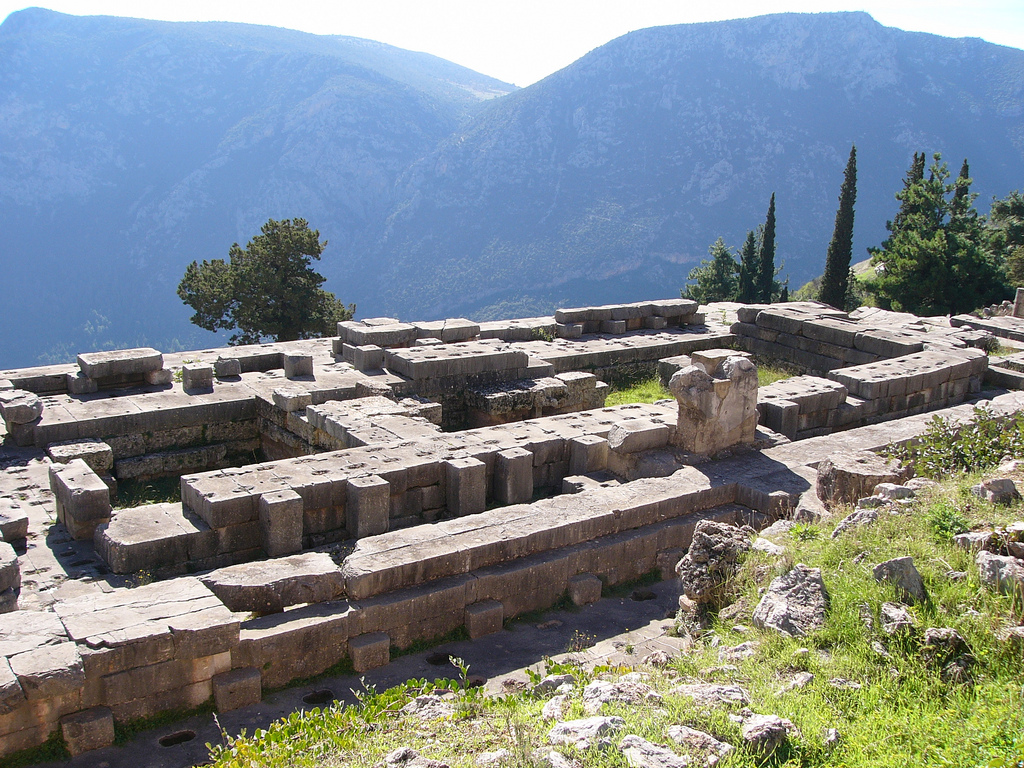
Greek mythology offers many versions of Delphi’s origin. Originally sacred to Gaia, the ‘Mother Goddess’, the site’s earliest worship was centred around the Korykeon Cave on Mount Parnassos. According to legend, Apollo slew the serpent (or she-dragon) Pytho here and claimed the sanctuary, adopting the name Apollo Pythios.
For over a millennium, pilgrims came in search of prophecy and guidance. Delphi’s golden age spanned from the 6th to the 4th century BCE, particularly after the Amphictyonic League — a federation of twelve tribal states — took control of the sanctuary following the First Sacred War (595–586 BCE). As an independent state, Delphi grew prosperous thanks to generous benefactors, including the kings of Lydia and Egypt, and the Roman emperor Hadrian. Although officially neutral, the sanctuary wielded considerable political influence.
Despite natural disasters like the fire of 548 BCE and the earthquake of 373 BCE, Delphi endured. It was seized by the Aetolians around 300 BCE and later fell to Rome in 191 BCE. Though plundered by the Roman general Sulla in 86 BCE, Delphi’s sacred rituals persisted into the 2nd century CE under later Roman emperors. Ultimately, the rise of Christianity led to its decline, and the sanctuary was closed by Emperor Theodosius in the late 4th century CE.
By the 7th century, the village of Kastri had grown atop the ruins. It remained there until the late 19th century, when residents were relocated to modern Delphi, making way for archaeological excavation.
Exploring the Sanctuary of Apollo
Allow at least an hour to experience the sanctuary’s highlights. Here’s a suggested walking route:
The Sacred Way
Entering from the sanctuary’s lower gate beside the main road, you’ll ascend the Sacred Way — restored in the 19th century. The first notable structure is the pedestal that once held the Bull of Kerkyra (Corfu). On the left lies the base of the Spartan Victory Monument, dedicated to Admiral Lysander. Further along, a small stone called the Omphalos marks the mythical navel of the ancient Greek world.
Sphinx of Naxos, Rock of the Sibyl, and Stoa of the Athenians
Northeast of the reconstructed Athenian Treasury stands a fragment of the column that supported the Sphinx of Naxos, now housed in the museum. Nearby is the Rock of the Sibyl, believed to be where Delphi’s earliest prophetess delivered her oracles. Just behind three columns of the Stoa of the Athenians is the impressive Polygonal Wall, once the foundation of the second Temple of Apollo (548 BCE), engraved with hundreds of finely carved inscriptions.
Temple of Apollo
At the sanctuary’s heart stands the ruins of the Temple of Apollo, rebuilt in the 4th century BCE. It once held a statue of the god and an eternal flame. This was where the Pythia — the oracle — sat in trance, delivering Apollo’s prophecies. Inscribed on the temple’s vestibule were the famous Delphic Maxims, such as “Know Thyself” and “Nothing in Excess,” later referenced by Socrates. Worshippers gathered not inside the temple, but outside in the open air.
Serpentine Column
Just east of the temple is a replica of the Serpentine Column (also known as the Tripod of the Plataeans), erected in 2015. The original commemorated the Greek victory over Persia at the Battle of Plataea (479 BCE) and now stands in Istanbul’s Hippodrome, having been moved there by Constantine the Great in AD 324.
Theatre and Castalian Spring
Above the Temple of Apollo lies the well-preserved theatre, dating to the 4th century BCE and later restored by King Loukumenes II. It hosted performances during the Pythian Games, held every four years. The view from its upper seats is stunning.
To the east, a stone path runs parallel to the main road and leads to the Castalian Spring. Here, pilgrims ritually purified themselves before entering the sacred sanctuary.
Visitor Information
Entry Fee: €12 (includes admission to the Delphi Archaeological Museum)
Free Entry: Every first Sunday of the month from November 1st to March 31st
Tip: Visit early in the morning or late in the afternoon to avoid heat and crowds
Note: Check official opening hours before visiting, as they can vary
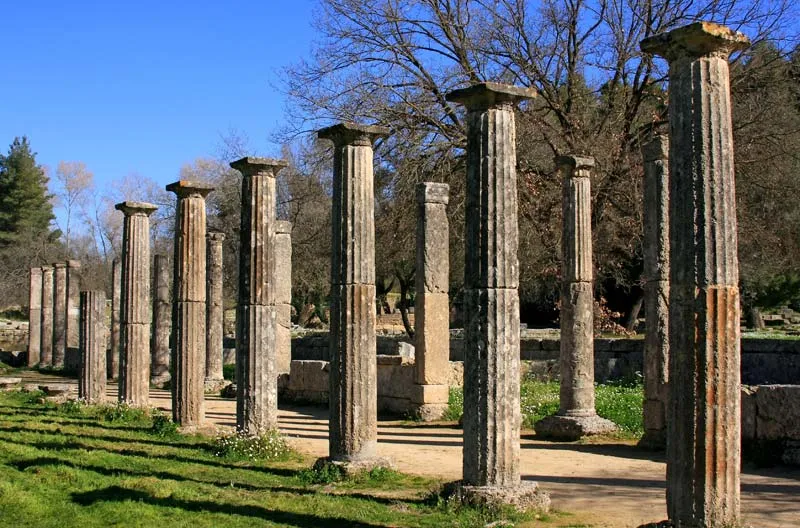
For over 1100 years, the ancient Olympic Games were held every four years at this sacred site, until Emperor Theodosius I banned them in AD 393. Today, the Olympic flame for the modern Games is still ignited here, a symbolic tribute to its origins. Although much of the once-splendid temples and athletic facilities were destroyed—first by imperial decree in AD 420 and later by a series of earthquakes—enough remains to stir the imagination and evoke the grandeur of the past.
Wandering through the shaded ruins, it’s easy to picture the blood and smoke of sacrifices offered to Zeus and Hera, the oiled athletes preparing for glory inside the stadium, and the roaring crowd eagerly awaiting the spectacle.
A Glimpse Into Olympia’s History
According to legend, Zeus created the Olympic Games to celebrate his victory over Kronos in a wrestling match. Archaeological evidence shows that the earliest structures at Olympia date between 2000 and 1600 BCE. The first recorded Olympic Games—originally part of a festival dedicated to Zeus—took place in 776 BCE. It’s important to note that the buildings span many centuries, and a visit to both the main archaeological museum and the Museum of the History of the Olympic Games in Antiquity offers valuable context for what you’ll see.
Exploring the Olympia Archaeological Site
Gymnasium & Palaestra (Wrestling School)
As you enter the site and descend the path, the first structure you’ll encounter is the gymnasium, built in the 2nd century BCE. South of it stand the remains of the palaestra, where athletes trained in wrestling and other sports.
Workshop of Pheidias
Just beyond lies the workshop of the famed Athenian sculptor Pheidias, who created the massive ivory-and-gold Statue of Zeus—one of the Seven Wonders of the Ancient World. Though the statue no longer exists, ancient texts and coin depictions preserve its memory. Archaeologists identified the workshop through the discovery of sculpting tools and moulds; it was later transformed into a Christian church in the 5th century CE.
The Altis – Sacred Precinct of Zeus
To the left of the entrance lies the Altis, the sanctuary’s spiritual core. At its heart stood the grand Doric Temple of Zeus (5th century BCE), once home to Pheidias’ monumental statue. One of the temple’s columns has been reconstructed, offering a sense of its original scale. Nearby, the base of the famous Nike statue (now in the museum) marks where it once stood.
Altar of Oaths & Bouleuterion
South of the Temple of Zeus is the bouleuterion, or council house, which housed the altar of oaths. Here, athletes swore to follow the Olympic rules and compete with honour. The building also kept official Games records and lists of champions.
The Stadium
To the east of the Altis lies the ancient stadium, accessed via a stone archway. The 192.27m-long track still features original stone start and finish lines, as well as judges’ seats. Capable of holding around 45,000 spectators, the stadium excluded women and slaves, who had to watch from the Hill of Kronos. In 2004, it was fittingly used for the Athens Olympics’ shot put event.
Temple of Hera
North of the Temple of Zeus is the late 7th-century BCE Doric Temple of Hera, the site’s oldest surviving temple. In front of it burned a sacred flame during the ancient Games, echoing the myth of Prometheus. Today, this very altar is where the Olympic flame is lit for every modern Games.
Tickets & Practical Information
Admission to Olympia is €12 and includes access to the archaeological site, the Archaeological Museum of Olympia, the Museum of the History of the Olympic Games in Antiquity, and the Museum of the History of Olympia Excavations.
To make the most of your visit, aim for early morning or late afternoon to avoid the crowds and enjoy the serene atmosphere. Informational signage is available in Greek, English, and German.
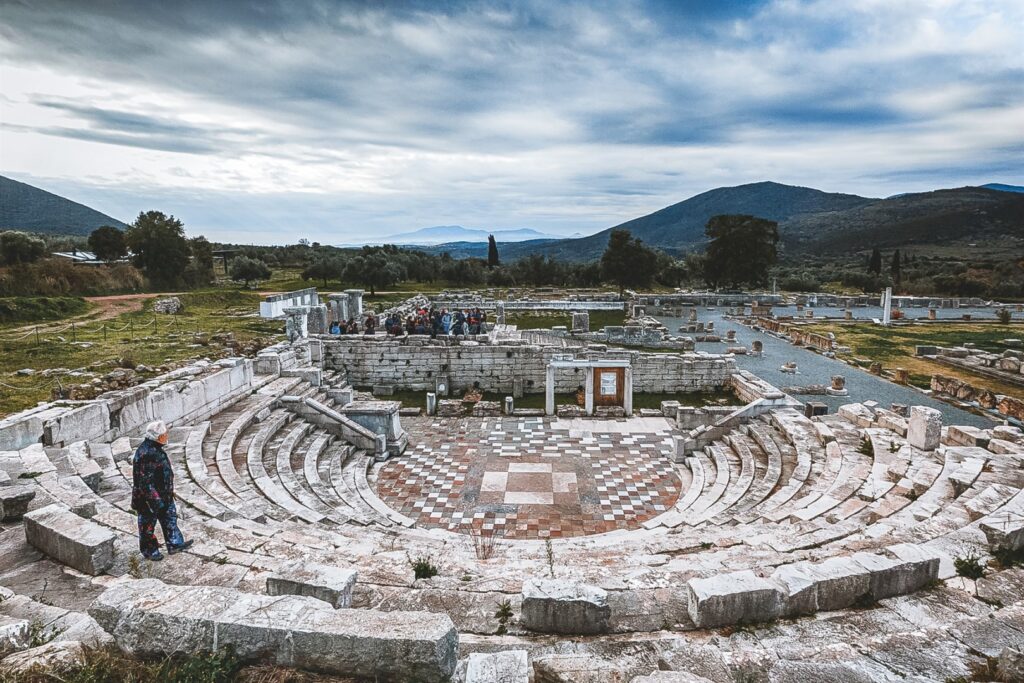
Step into the birthplace of the Olympic Games, where legends and athletes once converged in honour of Zeus. For over 1,100 years, Olympia hosted the sacred Games until their abolition in AD 393. Though time, earthquakes, and imperial orders have weathered the structures, Olympia’s aura still lingers.
Wander through the gymnasium and wrestling school, imagine the sculpting of the towering Statue of Zeus at Pheidias’ workshop, and explore the Temple of Zeus in the sacred precinct of Altis. Walk under the stone archway into the original stadium, where 45,000 spectators once roared. Nearby, the Temple of Hera still kindles the Olympic flame, connecting past and present in a timeless ritual.
Tip: Arrive early or late in the day to soak in the atmosphere without the crowds. Your €12 ticket includes three museums, giving context to this grand sanctuary.
Tucked beneath the village of Mavromati, Ancient Messini rivals Olympia in scale but offers a quieter, more immersive experience. Built in 371 BC after freedom from Spartan rule, this fortified city boasts some of Greece’s most complete ancient remains.
Start at the restored theatre, pass the Fountain of Arsinoe, and explore the vast agora, where a temple, bathhouse, and treasury stand. At the Sanctuary of Asclepius, admire Corinthian colonnades and Roman mosaics. Continue downhill to the awe-inspiring stadium, framed by columns and flanked by VIP seats, gladiator pits, and even ancient public toilets!
Don’t miss the Arcadian Gate 800m away—a marvel of ancient military architecture.
While Olympia celebrates divine athleticism, Messini offers a rare glimpse into ancient urban life, blending mythology, politics, and Roman influences. Each site tells a different chapter of Greece’s story, and visiting both gives you a fuller picture of its ancient glory.
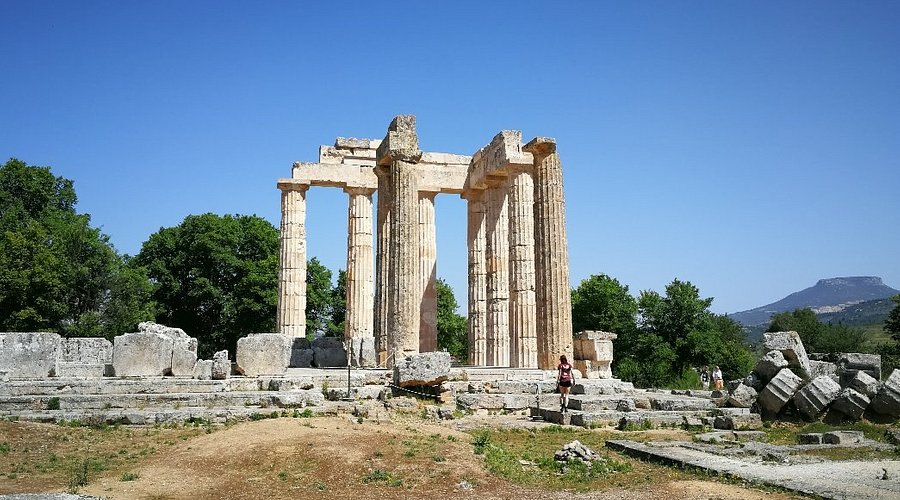
Set in a peaceful valley 31km southwest of Corinth, Ancient Nemea was once a major Panhellenic sanctuary of Zeus and the venue of the Nemean Games, held every two years like the Olympics. Though not a city, its spiritual and athletic legacy rivals that of Olympia and Delphi.
Start at the excellent museum, where detailed models take you from the site’s prime in 300 BC to its Christian revival in AD 500. Marvel at ancient sporting artefacts and stunning Mycenaean finds – especially the Gold of Aidonia, a glittering collection of rings, seals, and beads. A short video also explains the brilliant mechanics of the ancient race-starting system and the touching story of Nemea’s last Christian inhabitant.
Step outside to admire the Temple of Zeus, where three original columns now stand alongside six more reconstructed by an American team. Nearby are the remains of a bathhouse with pristine basins, and a guesthouse where athletes once stayed – perhaps even oiled and prepared for the Games.
A 300m walk through pine trees leads you to the stadium, which offers a dramatic view from above. For a more immersive experience, enter through the same stone tunnel once used by ancient athletes. The starting line, distance markers, and even graffiti still survive, creating a vivid sense of continuity across the centuries.
Every four years, the Modern Nemean Games bring the ancient site to life, welcoming visitors and runners from around the world to celebrate history through sport.
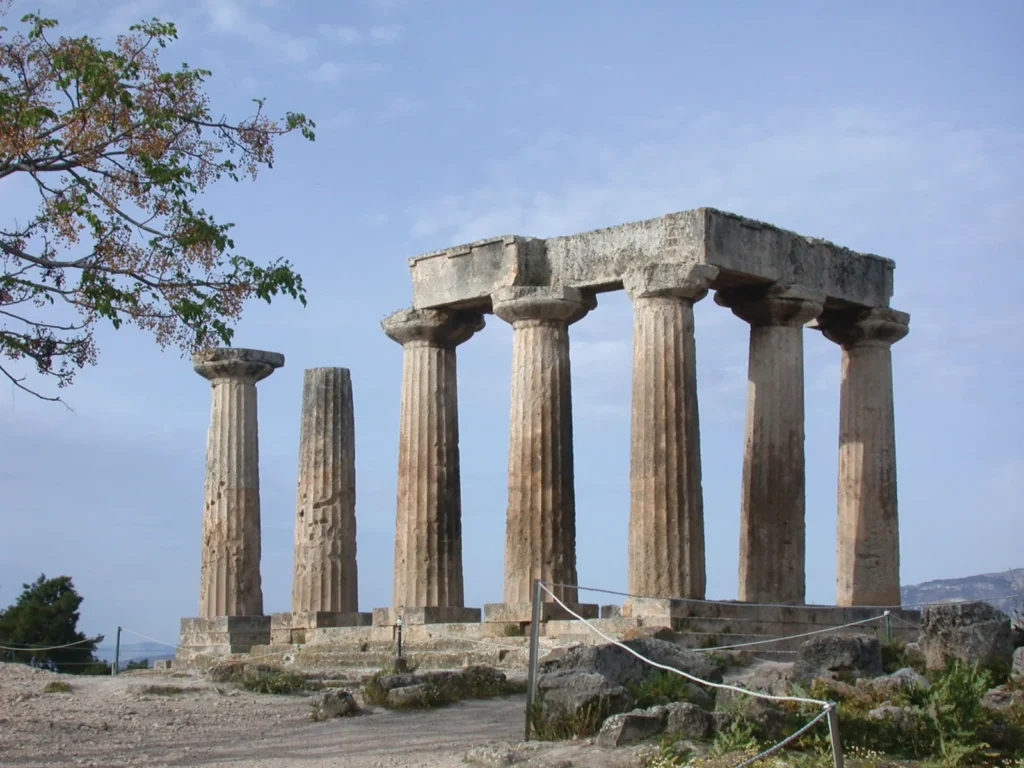
Tucked within the modern village, Ancient Corinth is a remarkably compact site with sprawling ruins, steeped in mythology, Roman grandeur, and Christian legacy. Once the home of Jason of the Argonauts and later a key centre for early Christianity, it offers a walk through centuries of layered history.
The site is dominated by the impressive 5th-century-BC Temple of Apollo, one of the few Greek monuments among the mostly Roman remains. To its south lies the vast agora, where Philip II of Macedon once convened city leaders under a grand 71-column stoa. In its heart is the bema, a raised marble platform where St Paul is believed to have defended his preaching.
To the east stands the remains of the Julian basilica, and to the north, the Lower Peirene fountain, born of myth – said to be the transformed tears of the grieving nymph Peirene. Steps westward lead to the Lecheon Road, once linking Corinth to its northern port. Nearby, the Peribolos of Apollo, framed by restored Ionic columns, and a Roman public latrine offer glimpses into daily life.
South of the main ruins, you’ll find the columns of Temple E, possibly dedicated to Octavia, sister of Emperor Augustus.
No visit is complete without exploring the on-site museum, an excellent introduction and conclusion to your tour. Highlights include two reclaimed kouros statues, exquisite Greek and Roman sculptures, mosaics, votive offerings, and intricate theatre reliefs displayed in a peaceful courtyard.
Opposite the main gate, visit the ancient theatre (5th century BC), once filled with 15,000 spectators, and the Roman odeion, a smaller indoor venue from the 1st century AD.
From myth and military alliances to Roman elegance and Christian sermons, Ancient Corinth offers a unique cross-section of Mediterranean history, all within easy walking distance.

Set in the heart of the mountain town of Kalavryta, this powerful museum stands as a solemn tribute to the 13 December 1943 massacre, when German occupying forces executed 465 men and teenage boys in retaliation for partisan activity in the region. Housed in the old schoolhouse – once set ablaze with women and children inside – the museum offers a deeply moving account of the tragedy through personal testimony, haunting photos, and everyday objects.
The exhibitions walk you through the turbulent 19th and 20th centuries in Kalavryta, from the arrival of the famed rack-and-pinion railway to the town’s pivotal role in the WWII resistance. The resistance group ELAS was active here, and the capture of 80 German soldiers in October 1943 sparked a brutal chain of events. After negotiations failed, the partisans executed the prisoners, triggering Operation Kalavryta. The Nazi response was swift and devastating – the men were marched to Kappi Ridge and executed; only 13 survived. Meanwhile, the village was set on fire.
Inside the museum, continuous-loop video testimonies from survivors – many children at the time – bring the horror and resilience of the townspeople to life. The final room, filled with portraits and names of the dead, is a stark and powerful memorial. Just behind the schoolhouse, statues honour the women and children left to bury their loved ones and rebuild amid the ashes.
A visit here is sobering but essential – a reminder of the human cost of war and the quiet strength of a community that refused to be broken.
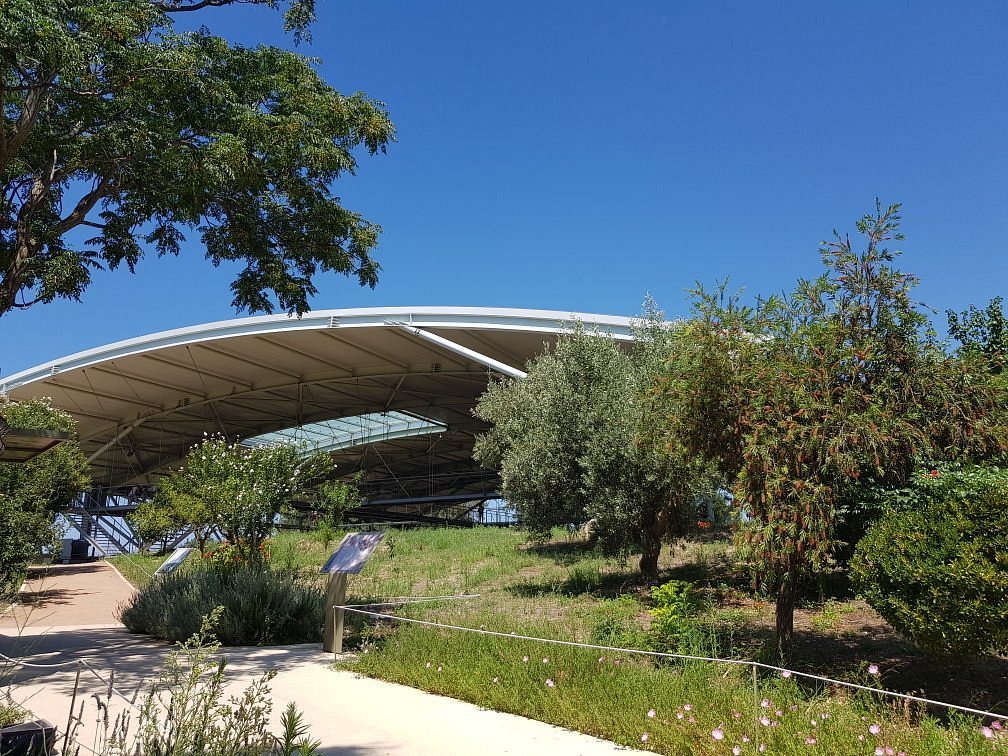
Just 17km north of Pylos, the Palace of Nestor is the best-preserved Mycenaean palace on mainland Greece – and an atmospheric walk through the world of Homer’s Odyssey. This was the court of King Nestor, the wise old warrior who sailed with the Argonauts and led 90 ships to Troy. The site, complete with raised walkways and informative panels, offers a vivid sense of how Mycenaean palace life unfolded more than 3,000 years ago.
The palace’s main complex once rose two storeys high and included a vast array of rooms. At its heart lies the throne room, where a grand circular hearth is still visible, once flanked by four ornate columns. Nearby are storerooms, a pantry, a vestibule, and the remains of a sentry post. Perhaps most captivating is the royal bathroom, complete with its terracotta bathtub – said to be the very one in which Polycaste, Nestor’s daughter, bathed Telemachus, son of Odysseus. Tiny ceramic cups used for oils and water still lie where they were found.
The palace was destroyed by fire around 1200 BC, and one collapsed storeroom still holds the charred remains of a shelf and crockery, frozen in time. Nearby, remnants of an older palace, workshops, and a wine cellar help paint a broader picture of palace life and production.
A small information kiosk near the ticket office provides background on the site’s excavation and the remarkable Linear B tablets found here – the first discovered on the Greek mainland and later revealed to be the earliest form of written Greek.
Don’t miss the nearby Chora Archaeological Museum, which houses many of the site’s fresco fragments, pottery, and replicas of the Linear B tablets.
Before leaving, visit the tholos tomb by the car park – a beautifully reconstructed Mycenaean beehive tomb, likely built for someone of royal lineage.
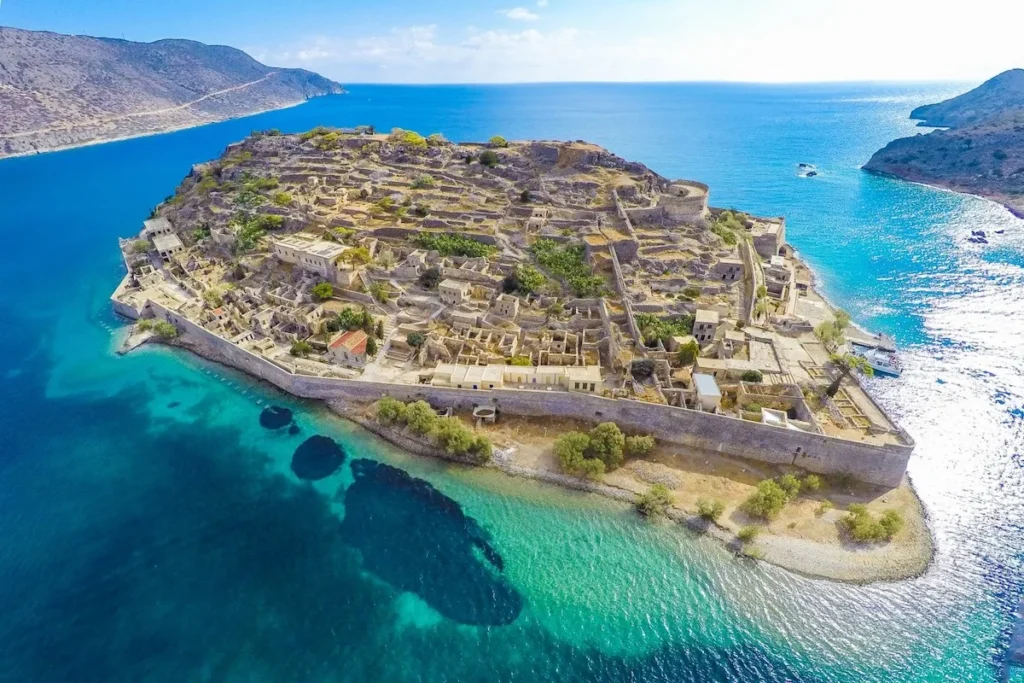
Just off the northern tip of the Spinalonga Peninsula lies the tiny island of Spinalonga, whose layered history has captured the imagination of readers and viewers worldwide thanks to Victoria Hislop’s bestselling novel The Island and the popular TV series To Nisi.
Originally fortified by the Venetians in 1579 to guard the bays of Elounda and Mirabello, the massive fortress walls still stand as a testament to its strategic importance. In 1715, Ottoman forces took control, adding to the island’s rich history.
Spinalonga’s remote location later made it the perfect place for a leper colony, established in 1903 to isolate those suffering from Hansen’s Disease. At its peak, around 1,000 patients lived here, enduring harsh conditions until gradual improvements began in the 1930s, largely thanks to the efforts of Epaminondas Remoundakis, a former patient and advocate for better care.
The colony was closed in 1957, after the discovery of an effective cure in 1948. Today, visitors arrive via ferries from Elounda, Plaka, or Agios Nikolaos, landing at Dante’s Gate — the tunnel through which patients once passed. A 1km trail leads past the island’s ruins: a church, the disinfection room, the hospital, and the cemetery, offering a poignant glimpse into life here.
Thanks to Hislop’s novel, Spinalonga is no longer a forgotten outpost but a vivid historical site, drawing many visitors eager to explore its evocative ruins and hear the stories that echo through its walls.
WhatsApp us